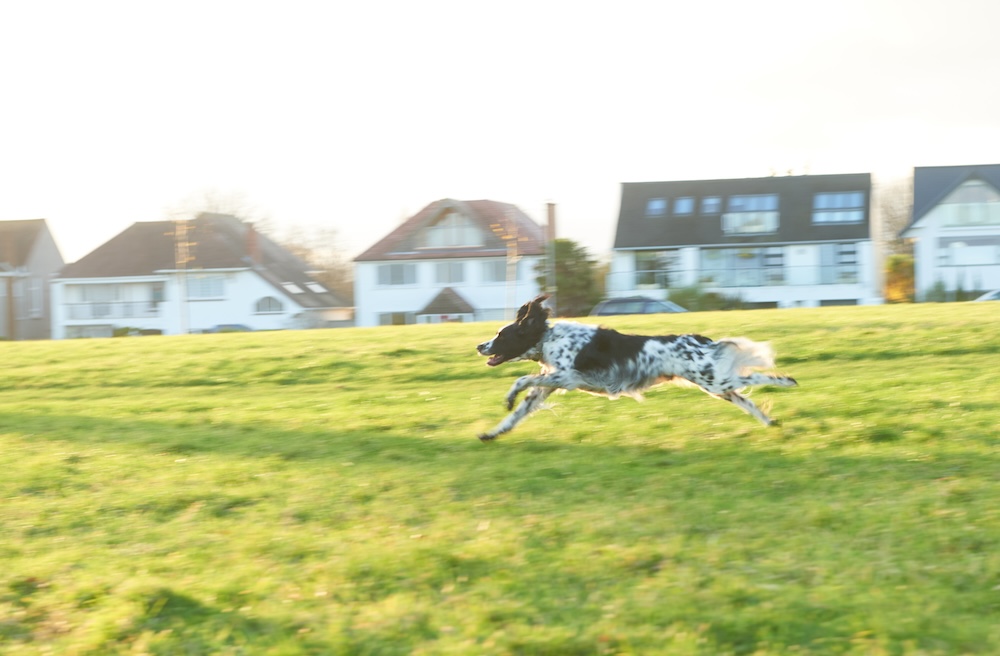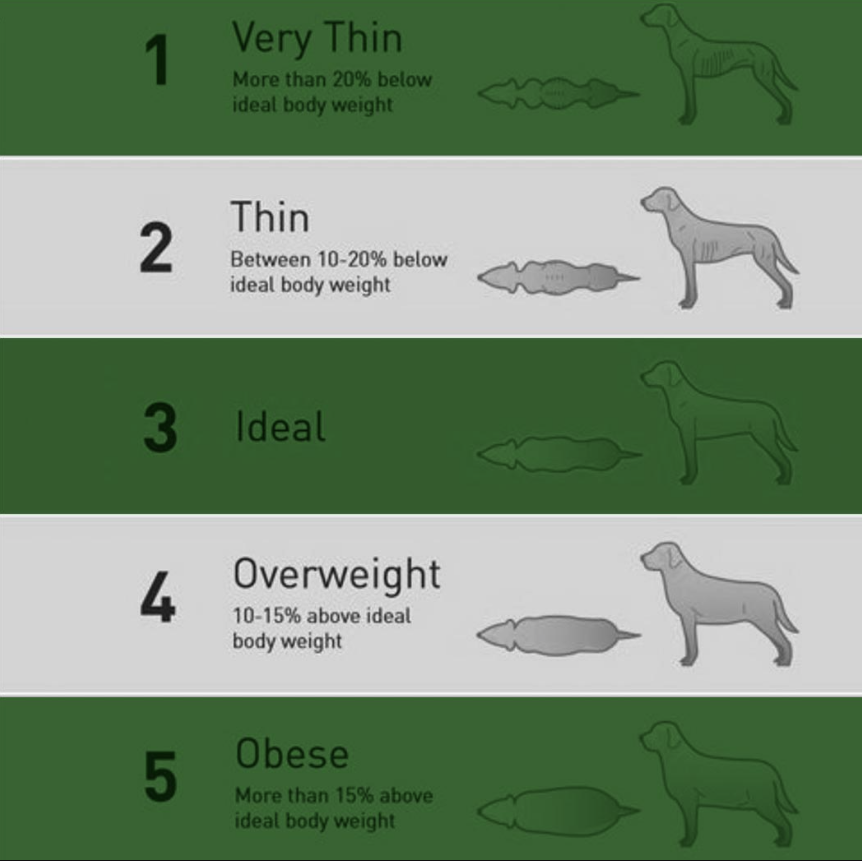I THINK MY DOG IS OVERWEIGHT - WHAT CAN I DO?
Discover exercise and diet tips for healthy dog weight loss

Quick takeaways about dog weight loss
- Around 7% of dogs are overweight in the UK.
- Dogs of a healthy weight live around 2.5 years longer than overweight dogs.
- Restricting treats and swapping overly processed for more natural food like raw can help.
If you suspect your dog might be overweight, you’re not alone. Around 7% of dogs are recorded as overweight by vets each year, reported a study by the Royal Veterinary College.
And, canine obesity is the most common nutritional disorder in dogs, according to The Kennel Club.
Just like us, lots of dogs love their food – and it can be difficult to keep their diet and exercise on track.
But, there’s plenty you can do to help your dog lose a few kilos if they need to – and help them maintain a healthy weight for good.
Here, we share why maintaining a healthy weight is so important for dogs, and what you can do to keep your dog’s weight in check.
Why is healthy weight management so important?
Sticking to a healthy weight has the same health benefits for dogs as it does for us – and there are plenty of them.
For starters, dogs that are a healthy weight live on average 2.5 years longer – according to a study published in the Journal of Veterinary Internal Medicine.
Being overweight means dogs are more likely to develop the same sort of illnesses as humans. So, maintaining an ideal weight can help to prevent the onset of a whole range of medical complaints, too.
The health risks of being overweight
From arthritis to diabetes, the reasons to keep your dog in shape soon stack up.
Common health risks associated with dog obesity can include:
- Heart disease
- Diabetes
- Arthritis
- Cardio-respiratory disorders
- Hormone problems
- Skin complaints
- Urogenital disorders (like bladder infections and kidney dysfunction)
- Certain cancers
How do you know if your dog is overweight?
Look up the ideal weight for your dog’s breed and gender, then weigh them using weighing scales to see how they compare.
It might be a good idea to do this at the vet, as they can help you understand your dog’s weight more easily.
You can also check your dog’s Body Condition Score (BCS) by taking a visual record of your dog and using this chart.

A healthy dog has a slight hourglass shape when you look from above. From the side, your dog’s torso should gently angle upwards towards their hind legs.
You should be able to feel their ribs and backbone as well as a thin layer of fat cushioning them – similar to the feel of knuckles on a hand lying flat.
If you can’t feel any bones, or your dog isn’t this hourglass shape, they might be overweight.
There are more helpful resources for owners worried about their dog’s weight here.
7 ways to help your dog lose weight
From diet changes to encouraging more exercise, there are a few ways you can help your dog lose weight healthily.
1. Change up their diet
If your dog is getting more carbohydrates than protein in their diet, they could be prone to gaining weight.
Carbs provide lots of instant energy, but if that energy isn’t used up straight away, it gets stored as fat.
High-protein, low-carbohydrate diets may help with weight loss in dogs, according to a study published in the Journal of Nutrition.
So, it’s worth checking that you’re feeding your dog a good balance. Check out our complete and balanced Natures Menu meal plans for a healthier option.
2. Keep an eye on those treats
It can be hard to resist those puppy-dog eyes at the table, or that wagging tail when the treat bag comes out.
But, just like with a human diet, too much of certain foods can cause weight gain – and too many treats can often be to blame.
The odd healthy treat is a great way to reward and encourage good behaviour, but avoid feeding your dog anything sugary or high in fat.
Natures Menu’s Meaty Treats or Superfood Bars are a great way to give them a tasty and healthy treat.
3. Check the ingredients carefully
Keep an eye out for sugar or any cheap bulking ingredients in your dog’s food, which may well be snuck into the ingredients list if it’s highly processed.
None of our recipes include these, so you can be sure you’re only feeding your dog the good stuff.
4. Consider a raw food diet
Switching to raw can be a great way to dial up the protein in your dog’s diet and reduce the carbohydrates – which will help to bring down their weight.
Our 80/20 nuggets are made with 80% meat and offal, and 20% fruits and vegetables. They also make portion control easy, as you can count out the number of nuggets you need – eliminating waste and overfeeding.
Find out how to switch to raw here.
5. Change how much you feed them
If you have an overweight dog, it’s important to feed for the weight you want them to be, rather than their current weight.
If there’s a big difference between the two, we recommend reducing the amount you feed over a few weeks to help them adjust as they lose weight.
Remember to introduce any changes – both in terms of type and quantity of food – gradually.
6. Encourage more exercise
Once your dog is on a raw, natural, and nutritious diet you may notice a boost in their energy levels.
After all, what we eat affects how we feel, and foods that lack nutrients or are difficult to digest can leave us – and our dogs – feeling sluggish.
With the right nutrients fuelling them, you might notice your dog is raring to get up off the sofa – so embrace it!
More exercise means more calories burned, more fat lost, and more muscle built – all of which will help with healthy dog weight loss.
7. Be patient and consistent
Losing weight is a journey, so you’re going to need to bear with your dog as you introduce changes, rather than expecting an instant solution.
Being consistent with your new feeding and exercise habits will bring results – and it’ll be well worth the effort in the long-run.
Dog weight loss FAQS
Are there any specific dog breeds prone to being overweight?
While any dog can pile on the pounds, these breeds are considered more prone to weight gain, according to the Royal Veterinary College:
- Pugs
- Beagles
- English Springer Spaniels
- Cavalier King Charles Spaniel
- Golden Retrievers
What are some good low-fat dog food ideas?
Opt for lean proteins like chicken or turkey in their food. Our 80/20 range is high in protein and is reinforced with superfoods.
You might also want to check the calorie levels of each recipe on our website to make sure you’re feeding a selection of lower options.
How can I help my dog lose weight safely?
Go for gradual changes. If your dog currently weighs 16kg, and their target weight is 10kg, you can start by calculating their portion amount based on 14kg.
Once they get down to 14kg, you can then recalculate the portion size based on 12kg and so on. Dogs with medical issues may need a specialist feeding schedule, so always discuss this with your vet before you begin.
Try our personalised meal plans with high-quality raw ingredients to help keep your dog healthy and happy.
